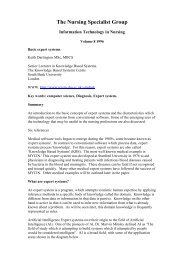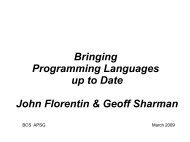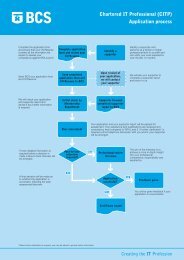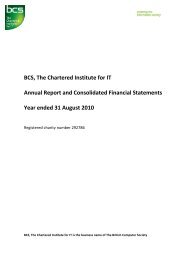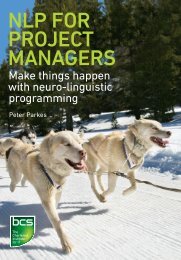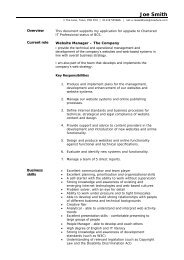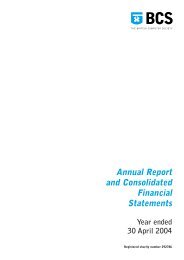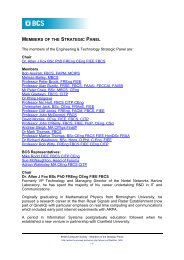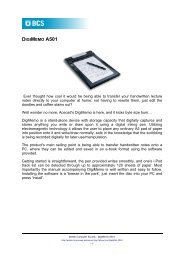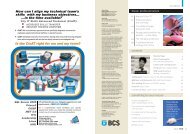SIREn: Entity Retrieval System for the Web of Data - BCS
SIREn: Entity Retrieval System for the Web of Data - BCS
SIREn: Entity Retrieval System for the Web of Data - BCS
- TAGS
- entity
- retrieval
- www.bcs.org
Create successful ePaper yourself
Turn your PDF publications into a flip-book with our unique Google optimized e-Paper software.
2.2. <strong>SIREn</strong> Query Model<br />
<strong>SIREn</strong>: <strong>Entity</strong> <strong>Retrieval</strong> <strong>System</strong> <strong>for</strong> <strong>the</strong> <strong>Web</strong> <strong>of</strong> <strong>Data</strong><br />
Since RDF is semi-structured data, we expect three types <strong>of</strong> queries: 1. full-text search (keyword<br />
based), 2. semi-structural queries (complex queries specified in a star-shaped structure), 3. or a<br />
combination <strong>of</strong> <strong>the</strong> two (where full-text search can be used on any part <strong>of</strong> <strong>the</strong> star-shaped query).<br />
We present in this section a set <strong>of</strong> query operators over <strong>the</strong> content and structure <strong>of</strong> <strong>the</strong> data tree<br />
that cover <strong>the</strong> three types <strong>of</strong> queries.<br />
2.2.1. <strong>SIREn</strong> Operators<br />
Content operators The content query operators are <strong>the</strong> only ones that access <strong>the</strong> content <strong>of</strong> a<br />
node, and are orthogonal to <strong>the</strong> structure operators. They include extended boolean operations such<br />
as boolean operators (intersection, union, difference), proximity operators (phrase, near, be<strong>for</strong>e,<br />
after, etc.) and fuzzy or wildcard operators.<br />
These operations allow to express complex keyword queries <strong>for</strong> each node <strong>of</strong> <strong>the</strong> tree. Interestingly,<br />
it is possibly to apply <strong>the</strong>se operators not only on literals, but also on URIs (subject, predicate and<br />
object), if URIs are normalized (i.e. tokenized). For example one could just use an RDF local name,<br />
e.g. name, to match foaf:name ignoring <strong>the</strong> namespace.<br />
Structure operators In <strong>the</strong> following, we define a set <strong>of</strong> operations over <strong>the</strong> structure <strong>of</strong> <strong>the</strong> data<br />
tree. Thanks to <strong>the</strong>se operations, we are able to search content to limited tree nodes, to query node<br />
relationships and to retrieve paths <strong>of</strong> nodes matching a given pattern. Joins over paths are possible<br />
using set operators, enabling <strong>the</strong> computation <strong>of</strong> entities and datasets matching a given star-shaped<br />
query.<br />
Ancestor-Descendant: A//D A node A is <strong>the</strong> ancestor <strong>of</strong> a node D if it exists a path between A<br />
and D. For example, <strong>the</strong> SPARQL query in Listing 1, line 1, can be interpreted as an Ancestor-<br />
Descendant operator, line 2, and will return <strong>the</strong> path 〈1.2.2.1〉.<br />
Parent-Child: P/C A node P is <strong>the</strong> parent <strong>of</strong> a node C if P is an ancestor <strong>of</strong> C and C is exactly one<br />
level above P. For example, <strong>the</strong> SPARQL query in Listing 1, line 3, can be translated into a<br />
Parent-Child operator, line 4, and will return <strong>the</strong> path 〈1.1.1.1〉.<br />
Set manipulation operators These operators allow to manipulate nodes <strong>of</strong> <strong>the</strong> tree (context,<br />
subject, predicate and object) as sets, implementing union (∪), difference (\) and intersection<br />
(∩). For example in Listing 1, <strong>the</strong> SPARQL query, line 5, can be interpreted as two Parent-Child<br />
operators with <strong>the</strong> intersection operator (AND), line 6.<br />
In addition, operators can be nested to express longer path as shown in Listing 1, line 7 and 9.<br />
However, <strong>the</strong> later is possible only if deeper trees have been indexed, i.e. 2-hop outgoing and<br />
incoming relations <strong>of</strong> an entity.<br />
Listing 1: SPARQL queries and <strong>the</strong>ir <strong>SIREn</strong> interpretation<br />
1 SELECT ?g WHERE { GRAPH ?g { deri ?p renaud }}<br />
2 deri // renaud<br />
3 SELECT ?g ?s WHERE { GRAPH ?g { ?s name "Renaud Delbru" }}<br />
4 name / "Renaud Delbru"<br />
5 SELECT ?g ?o WHERE { GRAPH ?g { giovanni knows ?o . deri employerOf ?o . }}<br />
6 knows^-1 / giovanni AND employerOf^-1 / deri<br />
7 SELECT ?s WHERE { GRAPH { ?s knows renaud }}<br />
8 renaud.delbru.fr // knows / renaud<br />
9 SELECT ?g ?s WHERE { GRAPH ?g { ?s employerOf ?o . ?o name "renaud" . }}<br />
10 employerOf // name / "renaud"<br />
2.2.2. SPARQL Interpretation<br />
In this section we discuss <strong>the</strong> extension by which, given <strong>the</strong> above discussed operators, it is possible<br />
to support a subset <strong>of</strong> <strong>the</strong> standard SPARQL query language.<br />
By indexing outgoing relations alone, we can show to cover <strong>the</strong> quad access patterns listed in<br />
Table 1. A quad lookup is per<strong>for</strong>med using <strong>the</strong> tuple operators. Join operations over <strong>the</strong>se patterns<br />
The 3rd <strong>BCS</strong> IRSG Symposium on Future Directions in In<strong>for</strong>mation Access<br />
33




